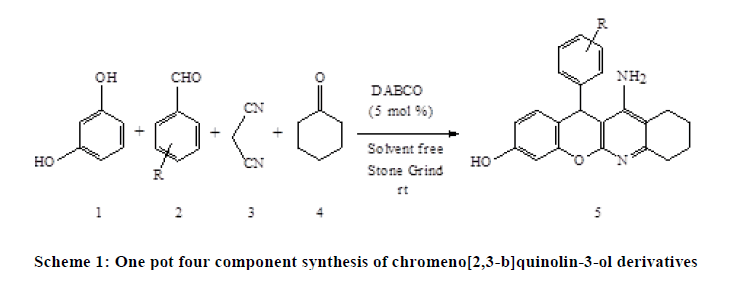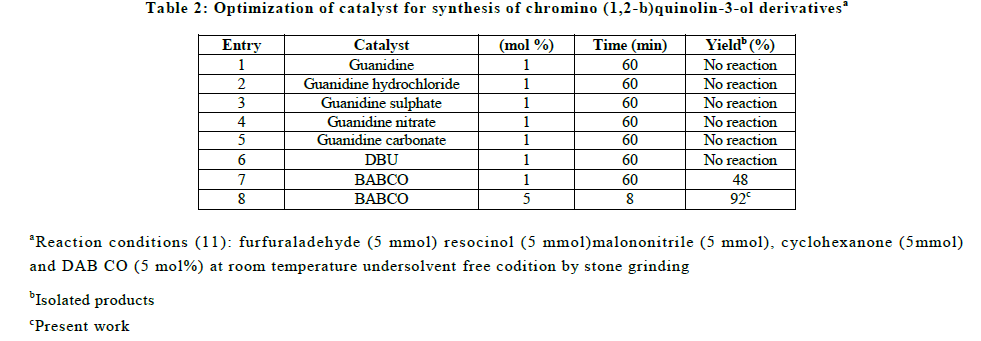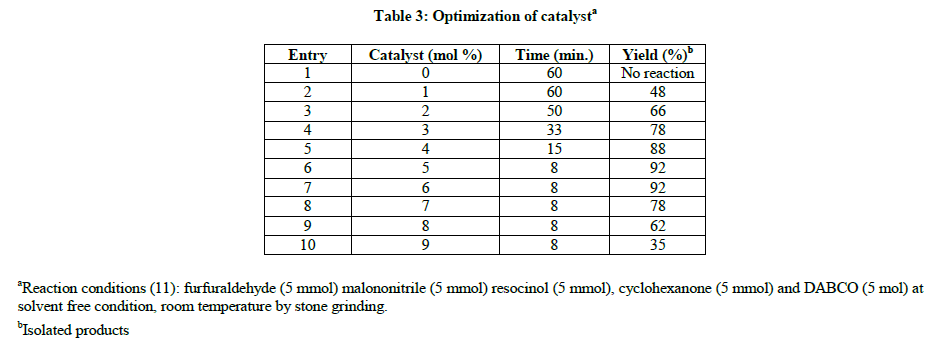Research Article - Der Pharma Chemica ( 2017) Volume 9, Issue 4
DABCO: An Efficient and Green Catalyst for One Pot Four-Component Synthesis of 11-Amino-12-(4-Aryl)-8,9,10,12-Tetrahydro-7H-Chromeno[2,3-b]Quinolin-3-ol Derivatives
Akash D Gholap1, Vishal U Pandit2, Abhijeet S Somwanshi1, Rushikesh D Ghogare1 and Shivaji S Pandit1*2Sun Pharmaceutical Industries Limited, Ahmednagar-414001, Maharashtra, India
Shivaji S Pandit, Department of Chemistry, Padmashri Vikhe Patil College of Arts, Science and Commerce, Affiliated to Savitribai Phule Pune University, Ahmednagar-413713, Maharashtra, India,
Abstract
A series of 11-amino-12-(4-aryl)-8,9,10,12-tetrahydro-7H-chromeno[2,3-b]quinolinol derivatives were synthesized through one-pot four-component reaction of resorcinol, malononitrile, aromatic aldehydes and cyclohexanone in presence of DABCO (diazabicyclo[2.2.2]octane) as an inexpensive catalyst under solvent-free condition using stone grinding techniques and at room temperature. The advantages of this method are the use of an inexpensive and green catalyst, short reaction time and easy workup with good to excellent product yields.
Keywords
Four component, One-pot, Chromeno[2,3-b]quinolinol derivatives, Solvent free
Introduction
Chromeno[2,3-b]quinolinol compounds are well-known and an important class of oxygenated heterocyclic compounds due to their various biological activities such as anti-allergic, anti-inflammatory and estrogenic [1,2]. Especially, chromeno [2.3-b]quinolinol derivatives exhibit anti-proliferative [3] cancer chemopreventive [4] and activities including anti-tubercular [5], hypotensive [6], anti-rheumatic [7] and antiasthmatic activities [8].
Two step synthesis of chromeno[2,3-b]quinolin-3-ol derivatives has been reported by the condensation reaction between 2-amino-3cyano-4H-chromene and cyclohexanone in presence of an excess anhydrous AlCl3 as a catalyst in CH2Cl2 under reflux condition as well as under controlled MW irradiations [9]. Synthesis of 4-[(N-Imidazol-2-yl methyl)anilino]pyranopyridine derivatives and 2-aryl-4H-pyrano[2,3-b]pyridin-4-ones has been reported [10,11]. Recently, one pot four component reaction using iron(III)triflate under solvent-free and ultrasonic irradiation conditions [12], ionic liquid and solid supports [13] has been reported. Therefore, for the increasing environmental and economic issues, still there is need to the development of a one-pot, four component efficient and rapid protocol for the synthesis of chromeno[2,3-b]quinolin-3-ol derivatives.
Though there are numerous synthetic methods have been reported for the synthesis chromeno[2,3-b]quinolin-3-ol derivatives among this; solvent-free stone grinding technique is simple, easy work up, high yield, convenient and require no special apparatus. Toda first introduces grind stone techniques [14] in organic synthesis. The reactions are initiated by grinding, with the transfer of very small amount of energy through friction. There are several organic transformations has been reported by applying grind stone techniques such as, Biginelli reaction [15], one-pot synthesis of spiro-indolinetriones [16], Cannizzaro reaction [17], Aldol condensation [18], and Knoevenagel condensation [19].
In continuation with our research for the development of novel MCRs using efficient catalysts [20-22], herein, we reports synthesis of various 11-amino-12-(4-aryl)-8,9,10,12-tetrahydro-7H-chromeno[2,3-b]quinolin-3-ol derivatives via one pot four-component reaction of resorcinol, malononitrile, aromatic aldehydes and cyclohexanone using the catalytic amount of DABCO (diazabicyclo[2.2.2]octane) under solvent free condition using stone grinding techniques at room temperature (Scheme 1).

Materials and Methods
Chemicals were purchased from Sd fine and Loba Chemical Companies. All yields refer to isolated products. The purity and completion of reaction was monitored by TLC. The analytical thin layer chromatography was performed on pre-coated silica gel plates (60F-254). The melting points were recorded in open capillaries and are uncorrected. IR spectra were recorded on a Shimadzu-IR 470 spectrophotometer. 1H NMR spectra was recorded on a Bruker Avance II 400 MHz spectrometer in DMSO as the solvent and tetramethylsilane (TMS) as the internal standard.
General procedure for synthesis of pyrano[2,3-b]pyridine derivatives
A mixture of resorcinol (5 mmol), malononitrile (5 mmol), aromatic aldehyde (5 mmol) and cyclohexanone (5 mmol) was mixed with DABCO (5 mol%) and the mixture was ground together in mortar with pestle at room temperature for an appropriate time as indicated in Table 1. The progress of the reaction was monitored by thin layer chromatography (TLC) (ethyl acetate: n-hexane, 1:5). After completion of the reaction, the mixture was washed with aq. NaHCO3 solution. The crude product was chromatograph on silica gel eluting with n-hexane-AcOEt (5:1). Spectral data for the products are as follows.
Entry 1
11-amino-12-phenyl-8,9,10,12-tetrahydro-7H-chromeno[2,3-b]quinolin-3-ol, mp 309–310°C, IR (KBr): 3440, 3365, 3018, 1614, 1527, 1238, 1111 cm−1. 1H NMR (100 MHz, DMSO-d6): δ=1.60 (m, 4H, CH2), 2.30 (m, 2H, CH2), 2.62 (m, 2H, CH2), 5.33 (s, 1H, CH), 6.75–7.45 (m, 10H, ArH, NH2), 9.60 (s, 1H, OH) (Table 1).
Entry 2
11-amino-12-(4-methoxyphenyl)-8,9,10,12-tetrahydro-7H-chromeno[2,3-b]quinolin-3-ol, mp: 295–297°C, IR (KBr): 3475, 3388, 2907, 1619, 1455, 1223, 1166 cm−1. 1H NMR (100 MHz, DMSO-d6): δ=1.55 (m, 4H, CH2), 2.25 (m, 2H, CH2), 2.40 (m, 2H, CH2), 3.75 (s, 3H, OCH3), 5.55 (s, 1H, CH), 6.25 (s, 2H, NH2), 6.6–7.4 (m, 7H, ArH), 9.75 (s, 1H, OH) (Table 1).
Entry 3
11-amino-12-styryl-8,9,10,12-tetrahydro-7H-chromeno[2,3-b]quinolin-3-ol, IR (KBr): 3470, 3385, 2900, 1610, 1450, 1220, 1160 cm-1. 1H NMR (100 MHz, DMSO-d6): δ=1.65 (m, 4H, CH2), 2.55 (m, 2H, CH2), 2.80 (m, 2H, CH2), 4.70 (s, 1H, CH), 6.35 (s, 2H, NH2), 6.2 (d, 1H, =CH), 6.4 (d, 1H, =CH), 6.5–7.30 (m, 7H, ArH), 9.80 (s, 1H, OH) (Table 1).
Entry 4
11-amino-12-(3,4,5-trimethoxyphenyl)-8, 9, 10, 12-tetrahydro-7H-chromeno[2,3-b]quinolin-3-ol, mp 281–282°C, IR (KBr): 3444, 3370, 2895, 1635, 1425, 1211, 1105 cm−1. 1H NMR (100 MHz, DMSO d6): δ=1.75 (m, 4H, CH2), 2.40 (m, 2H, CH2), 2.57 (m, 2H, CH2), 3.60 (s, 3H, OCH3), 3.65 (s, 3H, OCH3), 3.73 (s, 3H, OCH3), 5.14 (s, 1H, CH), 6.35 (s, 2H, NH2), 6.60–7.10 (m, 5H, ArH), 9.70 (s, 1H, OH) (Table 1).
Entry 5
11-amino-12-(4-chlorophenyl)-8,9,10,12-tetrahydro-7H-chromeno[2,3-b]quinolin-3-ol, mp 292–294°C, IR (KBr): 3422, 3150, 2885, 1624, 1448, 1233 cm−1. 1H NMR (100 MHz, DMSO-d6): δ=1.55 (m, 4H, CH2), 2.45 (m, 2H, CH2), 2.64 (m, 2H, CH2), 5.65 (s, 1H, CH), 6.15 (br, 2H, NH2), 6.72–7.42 (m, 7H, ArH), 10.10 (s, 1H, OH) (Table 1).
Entry 6
11-amino-12-(4-methylphenyl)-8,9,10,12-tetrahydro-7H-chromeno[2,3-b]quinolin-3-ol, mp 284–286°C, IR (KBr): 3455, 3365, 2910, 1613, 1433, 1218, 1165 cm−1. 1H NMR (100 MHz, DMSO-d6): δ=1.60 (m, 4H, CH2), 2.20 (s, 3H, CH3), 2.35 (m, 2H, CH2), 2.55 (m, 2H, CH2), 5.40 (s, 1H, CH), 6.10 (s, 2H, NH2), 6.45–7.20 (m, 7H, ArH), 9.63 (s, 1H, OH) (Table 1).
Entry 7
11-amino-12-(4-dimethylamino-phenyl)-8,9,10,12-tetrahydro-7H-chromeno[2,3-b]quinolin-3-ol, mp: >310 (decompose) IR (KBr): 3472, 3384, 2910, 1638, 1447, 1221, 1155 cm−1. 1H NMR (100 MHz, DMSO-d6): δ=1.72 (m, 4H, CH2), 2.2–2.70 (m, 4H, CH2), 2.90 (s, 6H, N(CH3)2), 5.25 (s, 1H, CH), 4.85 (brs, 2H, NH2), 6.60–7.10 (m, 7H, ArH), 9.45 (s, 1H, OH) (Table 1).
Entry 8
11-amino-12-(4-nitrophenyl)-8,9,10,12-tetrahydro-7H-chromeno[2,3-b]quinolin-3-ol, mp: 322–324°C. IR (KBr): 3425, 3390, 2865, 1630, 1510, 1435, 1325 cm−1. 1H NMR (100 MHz, DMSO-d6): δ=1.55 (m, 4H, CH2), 2.30–2.62 (m, 4H, CH2), 5.60 (s, 1H, CH), 6.35 (brs, 2H, NH2), 6.57–7.15 (m, 5H, ArH), 8.05 (m, 2H, ArH), 10.5 (s, 1H, OH) (Table 1).
Entry 9
11-amino-12-(4-hydroxyphenyl)-8,9,10,12-tetrahydro-7H-chromeno[2,3-b]quinolin-3-ol, mp: >330°C, IR (KBr): 3455, 3410, 3377, 1652, 1468, 1313, 1205 cm−1. 1H NMR (100 MHz, DMSO-d6): δ=1.60 (m, 4H, CH2), 2.40–2.75 (m, 4H, CH2), 5.55 (s, 1H, CH), 5.70 (brs, 2H, NH2), 6.65–7.05 (m, 7H, ArH), 10.10 (brs, 2H, OH) (Table 1).
Entry 10
11-amino-12-(4-N,N-dimethylamino-styryl)-8,9,10,12-tetrahydro-7H-chromeno[2,3-b]quinolin-3-ol, mp: >320°C. IR (KBr): 3470, 3380, 2915, 1620, 1430, 1220, 1140 cm−1. 1H NMR (100 MHz, DMSO-d6): δ=1.62 (m, 4H, CH2), 2.5–2.80 (m, 4H, CH2), 2.90 (s, 6H, N(CH3)2), 5.1 (s, 1H, CH), 4.85 (brs, 2H, NH2), 6.0 (d, 1H, =CH), 6.2 (d, 1H, =CH), 6.60–7.10 (m, 7H, ArH), 9.45 (s, 1H, OH) (Table 1).
Entry 11
11-amino-12-(furan-2-yl)-8,9,10,12-tetrahydro-7H-chromeno[2,3-b]quinolin-3-ol, mp: 313–314°C, IR (KBr): 3470, 3392, 2875, 1637, 1449, 1228 cm−1. 1H NMR (100 MHz, DMSO-d6): δ=1.73 (m, 4H, CH2), 2.26-2.66 (m, 4H, CH2), 5.22 (s, 1H, CH), 6.44 (brs, 2H, NH2), 6.70–7.25 (m, 6H, ArH), 9.20 (s, 1H, OH) (Table 1).



Conclusion
In summary, an efficient and rapid one-pot four-component coupling of resorcinol, malononitrile, aromatic aldehydes and cyclohexanone to synthesis 11-amino-12-(4-aryl)-8,9,10,12-tetrahydro-7H-chromeno[2,3-b]quinolin-3-ol derivatives using DABCO (diazabicyclo[2.2.2]octane) under solvent-free conditions at room temperature has been described. The catalytic system afforded the corresponding chromeno[2,3-b]quinolin-3-ol derivatives with high purity products in good to excellent yields.
Acknowledgements
SSP thanks UGC, New Delhi, INDIA for financial assistance wide file no. 47-618/13 (WRO) dated 20/05/2014 and also thanks to SAIF Panjab University, Chandigarh for the 1HNMR and RYK College Nasik for IR spectral analysis.
References
[1] N. Yamada, N. Kadowaki, S. Takahashi, K. Umeza, Biochem. Pharmacol., 1992, 44, 1211.
[2] S. Lee, K.Y. Yi, S. Yoo, Bull. Korean. Chem. Soc., 2004 25, 207.
[3] G. Kolokythas, N. Pouli, P. Marakos, H. Pratsinis, D. Kletsas, Eur. J. Med. Chem., 2006, 41, 71.
[4] M.A. Azuine, H. Tokuda, J. Takayasu, F. Enjyo, T. Mukainaka, T. Konoshima, H. Nishino, G. Kapadia, J. Pharmacol. Res., 2004, 49, 161.
[5] S.K. Srivastava, R.P. Tripathi, R. Ramachandran, J. Biol. Chem., 2005, 280, 30273.
[6] M. Goto, O. Yaoka, T. Oe, PCT Int. Appl. WO 8401711 A1 19840510.
[7] Y. Maruyama, K. Goto, M. Terasawa, Ger. Offen. DE 3010751 19810806.
[8] K. Ukawa, T. Ishiguro, H. Kuriki, A. Nohara, Chem. Pharm. Bull., 1985, 33, 4432.
[9] D. Singh, D.S. Raghuvanshi, K.N. Singh, ARKIVOC (x), 2010, 305.
[10] L. Sunkyung, M.C. Sun, Y.Y. Kyu, K. Nakjeong, H. Chang, Bull. Korean Chem. Soc., 2005, 26, 4.
[11]V. Khlebinkov, K. Patel, X. Zhou, M.M. Reddy, Z. Su, F.S. Chiacchia, H.C. Hansen, Tetrahedron, 2009, 65, 6932.
[12] S. Damavandi, Heterocycl. Commun., 2011, 17, 79.
[13] R. Sugimura, K. Qian, D. Tomida, C. Yokoyama, Catal. Commun., 2007, 8(5), 770.
[14] F. Toda, K. Tanaka, A.J. Sekikawa, Chem. Soc. Chem. Commun., 1987, 4, 279.
[15] A.K. Bose. S. Pednekar, S.N. Ganguly, G. Chakraborty, M.S. Manhas, Tetrahedron. Lett., 2004, 45, 8351.
[16] R. Ghahremanzadeh, S. Ahadi, G.I. Shakibaei, A. Bazgir, Tetrahedron. Lett., 2010, 51, 499.
[17] A.F.M.M. Rahman, A.A. Kadi, Arabian. J. Chem.
[18] F. Toda, K. Tanaka, K.J. Hamai, Chem. Soc. Perkin Trans., 1990, 1, 3207.
[19] C.L. Raston, J.L. Scott, Green Chem., 2000, 2, 49.
[20] Z.J. Ren, W.G. Cao, W.Q. Tong, Synth. Commun., 2002, 32, 3475.
[21] A.S. Waghmare, S.S. Pandit, J. Saud. Chem. Soc.
[22] S.S. Pandit, S.K. Bhalerao, U.S. Aher, G. Adhav, V.U. Pandit, J. Chem. Sci., 2011, 123, 421.



